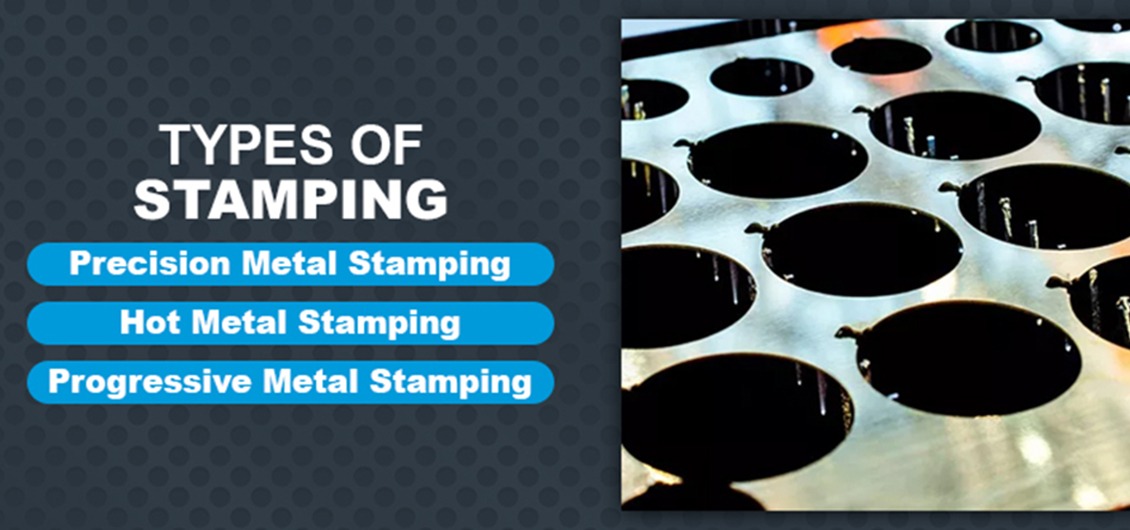Metal stamping is a complex manufacturing process used to transform flat metal sheets into shapes. Common among industries such as automotive, medical, and aerospace, thousands of companies across the U.S. offer metal stamping services. As a result of evolving global markets, the need for quickly-produced, complex parts has escalated.
This is where metal stamping shines – it is a fast, cost-effective solution for the needs of large-quantity manufacturing. Manufacturers seek out metal stamping for three key qualities: low cost, quick turnaround time, and high quality and durability.
The Basics of Metal Stamping
As a cold-forming process, metal stamping utilizes dies and stamping presses to convert pieces of flat sheet metal, or blanks, into different shapes. Metal fabricators feed blanks into a sheet metal stamping press that uses pressure to shape and shear the material into the desired form. Also referred to as pressing, metal stamping is a low-cost, high-speed manufacturing process that allows metal fabricators to produce a high volume of identical metal components.
Metal stamping is ideal for long or short production runs and may be conducted with other metal-forming operations. Some of the more common metal stamping techniques include blanking, punching, bending, flanging, embossing, and coining.
Blanking and punching refer to the use of a die to cut the metal. With the punching technique, as the “punch” enters the die, a scrap piece of metal is removed, leaving a hole in the workpiece. Conversely, blanking removes a workpiece from the primary metal. The removed metal is the desired workpiece.
Embossing creates either a raised or recessed design in the metal by pressing the blank metal against a die with the desired shape. Additionally, the sheet metal can be passed through a roller die.
Coining is a bending technique – the sheet metal is placed between a die and a punch, or press, and then stamped. During this process, the punch tip penetrates the metal and creates accurate, repeatable bends, relieving internal stress in the workpiece and thus creating no spring-back effects.
Bending is the process of forming metal into desired shapes such as L, U, or V-shaped profiles. Bending typically occurs around a single axis. The flanging technique introduces a flare or flange onto the metal using dies, presses, or specialized flanging machinery.
Types of Stamping Operations
Progressive Die Stamping
Progressive die stamping operates as a sequence of stamping stations. A metal coil is fed into a reciprocating stamping press with progressive stamping dies. Moving with the die, the press then forces the die to close, or stamp, the metal and form the part. When the press moves up again, the metal moves horizontally to the next station. Because the part is still connected to the metal strip, these movements must be precise.
At the final station, the newly-fabricated part is separated from the rest of the metal. Because the dies last a long time before becoming damaged, progressive die stamping is highly repeatable, making it ideal for long runs. Additionally, it is a faster process that creates little scrap.
Progressive Die Stamping
Transfer die stamping is similar to progressive die stamping but with one key difference: the workpiece is separated from the rest of the metal earlier in the process. It is then transferred from one stamping station to another using another mechanical transport system or conveyor belt. The technique is preferred for larger parts that may need to be transferred to different presses.
Four-Slide Stamping
Four-slide stamping, also known as multi-slide or four-way stamping, is ideal for creating complex components with bends or twists. Utilizing four sliding tools instead of one vertical slide, this type of stamping shapes the workpiece through multiple deformations. No dies are used; instead, two slides, or rams, horizontally strike the workpiece to give it its shape. Because four-slide stamping can utilize different tools, it is a versatile technique with relatively low cost and fast production.
Fine Blanking
Fine blanking, or fine-edge blanking, is ideal for jobs requiring high accuracy and smooth edges. This type of stamping is generally done on a hydraulic press, mechanical press, or a combination of the two. Fine blanking includes three distinct movements: (1) clamping the workpiece in place, (2) performing the blanking operation, and (3) ejecting the finished part.
Unlike other presses used in conventional stamping methods, fine blanking presses operate at higher pressures, equipped with tools specifically designed with this in mind. This technique creates workpieces with edges that are more unlikely to fracture and a surface flatness that exceeds what is possible with other stamping methods. As a cold extrusion technique, fine blanking is a single-step process. This equates to a reduction in the overall costs of fabrication.
Why Choose PFA for Your Metal Stamping Operations?
At PFA, we are the ideal partner for any metal stamping project. Our top priority is to guarantee consistent, high-quality results with every press. Our team works to determine the best stamping operation for your application, design, and, most importantly, your part or product. Let us help you put your stamp on the market by contacting us today or calling 262-250-4410.
Fairlawn Tool ‘s Hot Metal Stamping 101
Photo taken from fairlawntool.com


